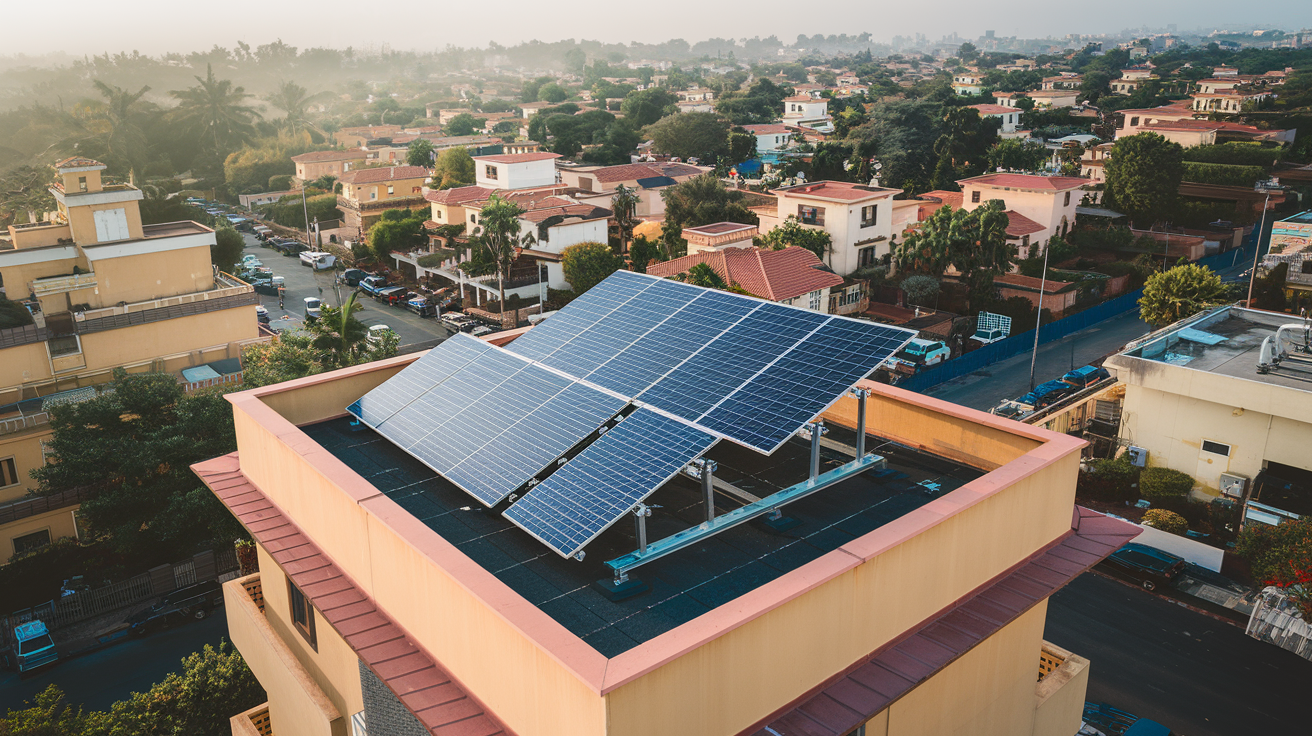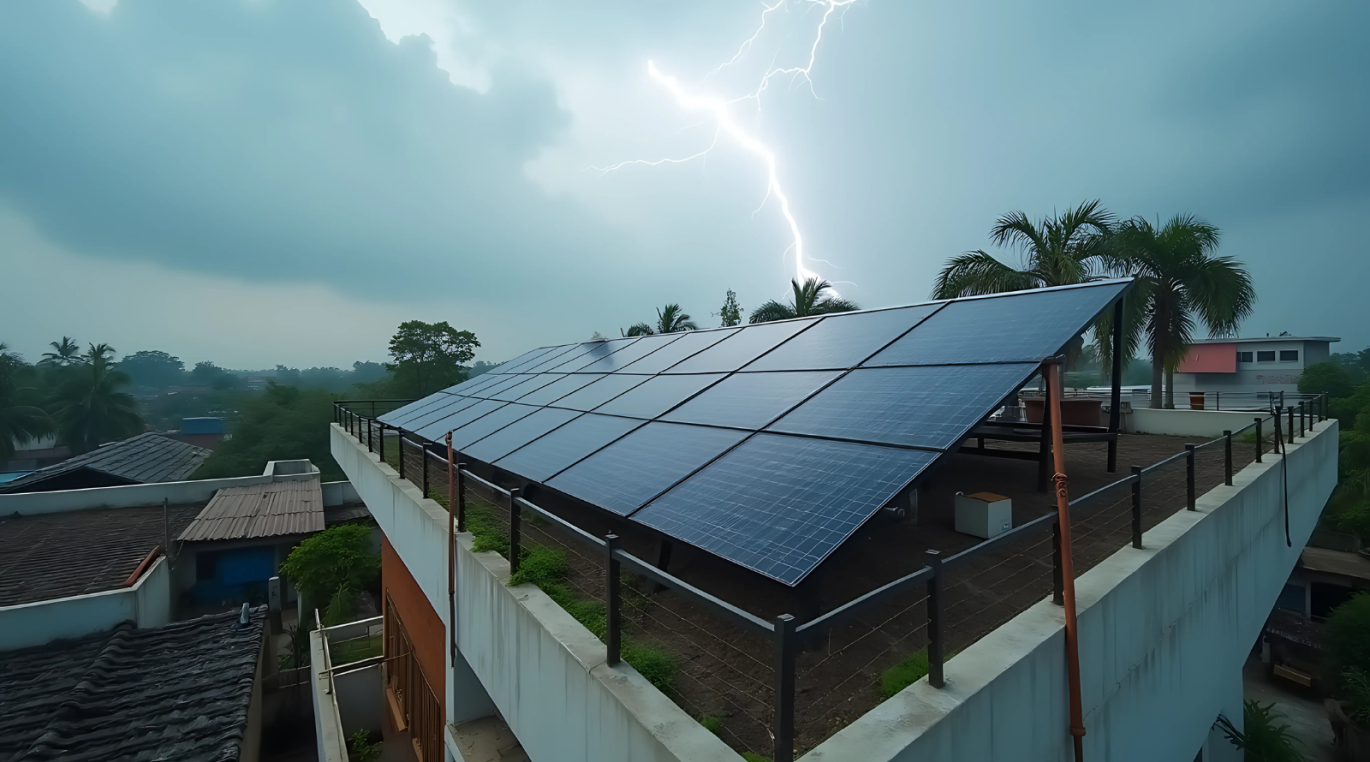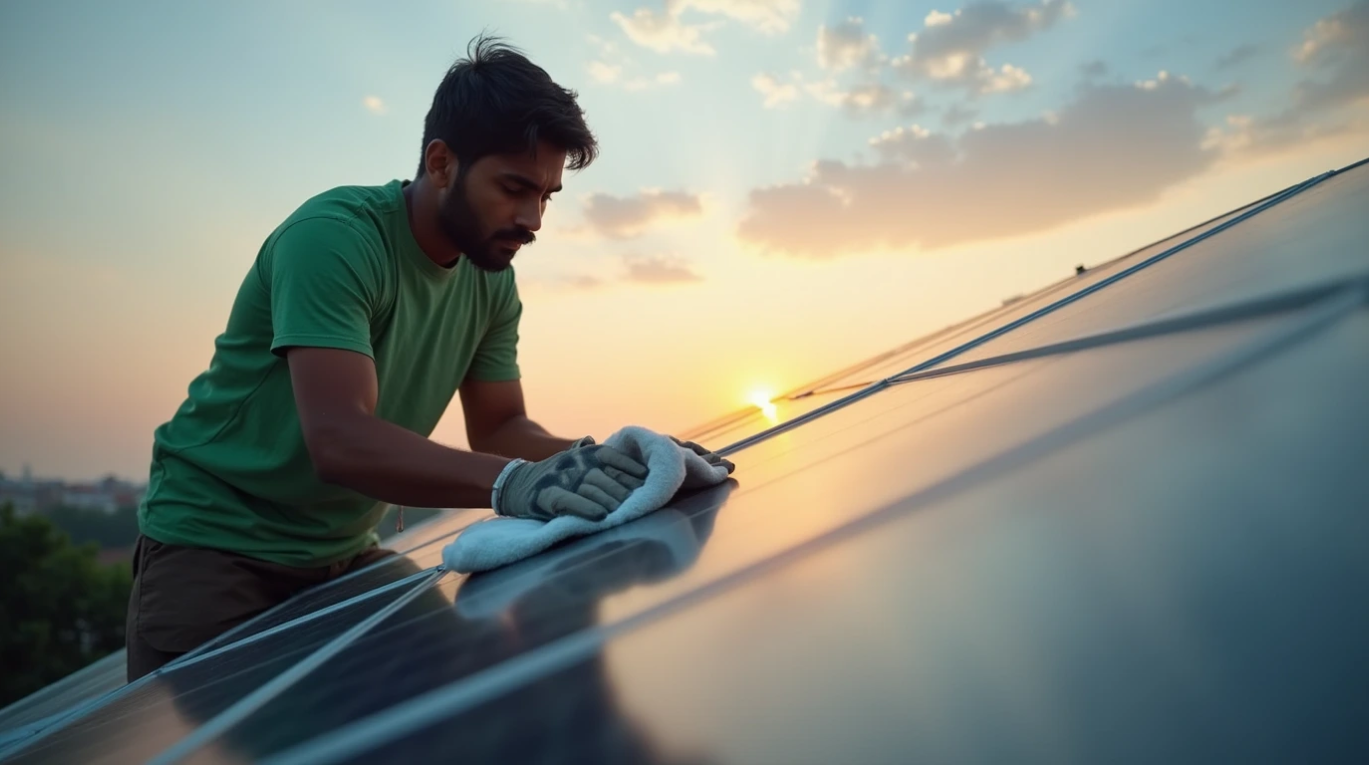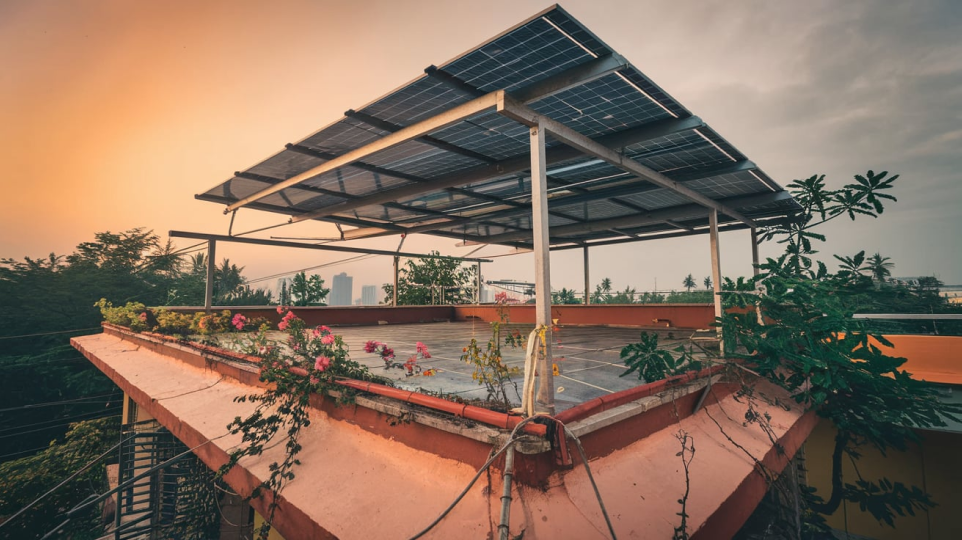A rooftop solar system is a long-term investment, powering your home or business for years. However, ensuring maximum efficiency requires more than simply mounting panels on your roof. Engineering plays a crucial role in optimizing each component, and the panel’s direction and tilt angle are especially critical. Positioning panels at the right angle and orientation allows them to absorb the maximum sunlight possible, boosting energy production and savings. In countries like the USA, latitude-based adjustments are common, with panels typically tilted at 30-45 degrees. In India, however, panels perform best when oriented towards true south, with an ideal tilt angle that varies by location. This article will cover the importance of the right angle and direction, factors affecting tilt angle, and advanced tools used in the industry to design efficient solar panel installations.What is the Ideal Solar Panel Direction and Angle in India?India is located in the northern hemisphere, so south-facing solar panels receive maximum sunlight. However, the optimal tilt angle depends on specific geographic locations: Southern India: Lower latitude areas, like Chennai, benefit from a flatter tilt angle, around 10 degrees. Northern India: Higher latitude regions, such as Delhi or Himachal Pradesh, require a steeper tilt, closer to 20-25 degrees.While south-facing orientation is generally optimal, slight adjustments can be made based on local conditions to enhance year-round performance. Instruments and Tools to Determine the Optimal Tilt Angle Modern solar installations leverage advanced tools and software to determine the best panel angle, direction, and placement. Here are some of the key instruments and software used in the industry: Digital Inclinometers These devices measure the tilt angle of a surface accurately. In solar installations, they help verify that panels are set at the correct angle during installation. Solar Pathfinders and Suneye Tools These handheld devices are used to perform onsite solar assessments, mapping the sun’s path throughout the year and identifying shading from nearby objects like trees or buildings. These tools are especially useful for complex rooftops or areas with potential shading issues. Google Earth Google Earth provides precise latitude and longitude data, which helps installers calculate the ideal tilt angle based on geographic location. This data forms the basis for other software tools to simulate sunlight exposure and shading. Google Sunroof Google’s Project Sunroof uses satellite imagery to estimate the solar potential of rooftops, calculating factors like sunlight exposure, shadow analysis, and potential electricity savings. It gives a clear overview of whether a property is well-suited for solar panels. Solar Design Software (OpenSolar, PVsyst) OpenSolar, PVsyst, and other advanced design software allow for in-depth analysis of solar installations. These platforms simulate how panels will perform based on angle, orientation, and environmental factors, considering details like local weather patterns and shading. By using these tools, solar designers can optimize energy production and make data-driven decisions for each site. Factors That Affect Solar Panel Angle Geographical Location Latitude is crucial in determining tilt angle. Northern India’s higher latitude means solar panels benefit from steeper angles to maximize winter sunlight capture. Southern regions, closer to the equator, use flatter angles for year-round solar gain. Wind Load Higher tilt angles can make panels more susceptible to wind loads, especially in areas with frequent storms. Ensuring a robust mounting structure that accounts for local wind conditions is essential for durability. Seasonal Adjustments Ideally, panel angles should adjust slightly throughout the year to match the sun’s seasonal movement. For installations that can’t adjust seasonally, a fixed angle optimized for annual solar gain is chosen. Shading Shading from nearby structures or trees can dramatically reduce a solar panel’s efficiency. During the site survey, shadow analysis tools like Google Sunroof or specialized shading software help identify potential obstructions and guide the optimal placement and tilt. Effect of Tilt Angle on Solar Panel Efficiency Tilt angle has a significant impact on solar panel performance. In northern India, a steeper angle enhances energy capture during winter but may increase wind load risks. Reinforced mounting structures mitigate this, providing stability while allowing panels to be set at efficient angles. Though stronger mounting might add around 5% to installation costs, it’s a worthwhile investment for long-term durability. Insufficient support may lead to damage during high winds, negating savings from solar energy. Why Does Solar Panel Angle Matter? Solar panels generate electricity by absorbing photons from sunlight. Panels positioned perpendicular to the sun maximize photon capture, converting more solar energy into electricity. Although the optimal panel angle enhances efficiency, seasonal and weather variations will still affect energy production. Cloudy or rainy weather, particularly during monsoons, can reduce sunlight exposure and electricity output. Addressing Shadow Issues on the Rooftop Even with the correct angle and direction, shadows from nearby trees, structures, or other buildings can significantly reduce solar panel efficiency. During site surveys, shadow analysis tools and solar design software assess shadow patterns across seasons. A rule of thumb is that 100 square feet of shadow-free space is needed per kilowatt. For rooftops with limited space or complex shading issues, consulting a solar expert can help identify viable solutions. Engineering the Perfect Solar Installation with Stellar Green At Stellar Green, we understand that a well-designed solar system goes beyond just installing panels. Our engineers and technicians follow a detailed, data-driven approach to ensure your rooftop solar system achieves maximum efficiency. Here’s how we handle it: Comprehensive Shadow Analysis Our experts conduct detailed rooftop surveys to identify shadow zones using Google Sunroof, Suneye, and other shading tools. We use geographic data from Google Earth and simulation tools like PVsyst to optimize panel placement and angle based on your specific location. Advanced Mounting Solutions Considering India’s storm-prone areas, we use heavy-duty mounting structures that withstand wind speeds over 180 kmph. This provides stability and protection, ensuring your system remains secure even in extreme weather. Switch to solar with Stellar Green and benefit from our engineering excellence. We design solar systems that perform reliably for years, maximizing your investment and energy savings. FAQs Does solar panel angle matter? Yes, the angle is critical for optimizing solar
Does Solar Work on Cloudy Days?
A common question surrounding solar energy is whether solar panels generate electricity on cloudy days. Many assume that solar panels require full, direct sunlight to function effectively, but that’s far from the truth. Solar panels are designed to capture sunlight even when it’s cloudy, ensuring they produce energy year-round. Here, we debunk the myths around solar performance in cloudy weather and provide a fact-based look at how solar works even when the sun isn’t shining at its brightest. How Solar Panels Work Solar panels operate based on the photovoltaic (PV) effect. When sunlight hits the photovoltaic cells (typically made of silicon), it energizes electrons, creating an electric current. This process doesn’t require only direct sunlight; it works with diffuse light as well, which is the sunlight scattered by clouds or particles in the atmosphere.In fact, even under cloud cover, sunlight still reaches the Earth, allowing the PV cells to absorb this light and generate electricity. While output might be reduced compared to clear-sky conditions, panels continue to produce energy on cloudy days. Performance on Cloudy Days Solar panels do experience reduced efficiency on cloudy days, but they don’t stop working. Typically, solar panels generate around 10-50% of their peak output under cloud cover, depending on factors like cloud thickness, geographic location, and panel orientation. This means that while energy production dips on cloudy days, it’s far from zero.For example: Lightly Overcast Days: Solar panels can operate at about 50-80% of their full capacity. Heavier Cloud Cover: Output may reduce to 10-25% of peak capacity, depending on the density of the clouds. Key Factors Affecting Solar Efficiency on Cloudy Days Cloud Thickness and Type: High, thin clouds allow more diffuse sunlight to reach panels, leading to higher efficiency. Low, dense clouds or storm clouds can block more sunlight, reducing efficiency significantly. Season and Time of Year: Solar production naturally dips during winter due to shorter daylight hours and a lower sun angle, which reduces the overall sunlight available, even on clear days. Geographic Location: Regions closer to the equator receive more sunlight throughout the year, even during overcast days. Conversely, locations farther from the equator may experience more seasonal variation and a more noticeable dip during cloudy periods. Weather Patterns: Areas with frequent cloud cover or long rainy seasons might see greater fluctuations in daily solar output. However, annual energy production can still be substantial, especially when systems are designed to optimize low-light conditions. Solar Energy Success in Cloudy Regions Many countries with cloudy climates, such as Germany and the United Kingdom, have thriving solar industries. In Germany, for example, solar energy contributes significantly to the national grid despite a climate known for frequent overcast days. This success is due to advances in solar panel technology, system design optimizations, and high-efficiency panels. How Good System Design Can Boost Solar Generation on Cloudy Days A well-designed solar system can significantly increase energy output, even on overcast days. Here’s how: Optimal Panel Orientation and Tilt: Positioning panels to capture maximum diffuse sunlight ensures higher efficiency during cloudy conditions. High-Efficiency Panels: Mono-crystalline and bi-facial panels are especially effective in low-light environments, absorbing both direct and reflected light. Advanced Inverters and Storage: Micro-inverters allow each panel to operate independently, optimizing energy conversion in variable lighting. Adding battery storage also stores excess energy from sunny days, providing backup during cloudy spells. Reflective Surfaces and Spacing: Reflective ground materials and proper panel spacing prevent shading and boost light capture, even in low-light scenarios. Common Myths About Solar and Cloudy Weather Myth 1: Solar Panels Don’t Work at All on Cloudy Days. Fact: Solar panels continue to produce electricity on cloudy days. While efficiency decreases, they can still capture and use diffuse sunlight, making solar viable even in less-than-ideal conditions. Myth 2: Solar Panels Only Work in Sunny Locations. Fact: While sunnier areas can maximize solar output, panels are effective in cloudy regions as well. With advancements in solar technology and proper system design, locations with variable weather can still achieve excellent energy returns. FAQs How much electricity do solar panels produce on overcast days? Solar panels typically produce between 10% and 50% of their peak capacity on overcast days, depending on cloud thickness and other weather factors. High-efficiency panels are designed to capture as much light as possible, even in low-light conditions, ensuring you still get energy production. How well do solar panels work on cloudy days compared to sunny days? Solar panel efficiency can decrease by 50-80% on cloudy days compared to full sun. However, even under cloudy skies, panels can continue to generate a significant portion of their peak capacity, especially during partly cloudy conditions. Does weather impact solar panel efficiency in other ways? Yes, weather can affect solar output in various ways. Rain, snow, and air pollution can reduce the amount of sunlight reaching the panels. However, cooler temperatures actually improve panel performance, making winter months productive in areas with clear skies. How can I maximize solar production on cloudy days? To maximize production, consider high-efficiency panels, proper tilt and orientation, and using smart inverters. Regular cleaning and maintenance also ensure the panels are clear of dust and debris, which can further enhance efficiency. About the Author aniketdas4040 Tags:Cloudy Weather Solar Performance, Renewable Energy, Solar Energy on Cloudy Days, Solar Panel Efficiency, Solar Panel Optimization, Solar Power in Low Light, Solar Power Tips, Sustainable Energy Share this blog: Facebook Whatsapp Linkedin Previous PostNext Post In this article How Solar Panels Work Performance on Cloudy Days Solar Energy Success in Cloudy Regions How Good System Design Can Boost Solar Generation on Cloudy Days Common Myths About Solar and Cloudy Weather FAQs Most Recent Posts All Posts Blog Residential Rooftop Solar Rooftop Solar Maintenance Solar Energy Optimization Solar Panel Cleaning Solar Panel Efficiency Solar Panel Placement Solar Panel Pricing Solar Power Optimization Sunlight Orientation Weather and Solar Energy What Should Be the Best Angle for a Solar Panel? Does Direction Matter? Does Solar Work on Cloudy Days? How to maintain your rooftop solar system? Power
How to maintain your rooftop solar system?
Investing in a rooftop solar system is an excellent way to reduce energy costs and contribute to a sustainable future. However, like any other home appliance, solar panels need regular maintenance to function at their best. Without proper care, your solar system’s efficiency and lifespan can suffer. A study conducted by reputed think tank CEEW in partnership with PV Diagnostics revealed that 80% of rooftop solar installations under performed due to dust and bird droppings. Furthermore, the performance of these systems dropped by ~30% within 2 years due to lack of maintenance.The truth is that without proper upkeep, even the best solar systems will under perform, leading to diminished savings and efficiency. This article will cover everything you need to know to keep your rooftop solar panels in top shape, including cleaning methods, frequency, and the benefits of professional maintenance services like those offered by Stellar Green. Why Regular Solar Panel Cleaning Is Necessary Regular solar panel cleaning is essential for optimal performance and long-term savings. Dirt, dust, bird droppings, and other debris can accumulate on the panel surface, blocking sunlight and reducing the system’s efficiency. A buildup of grime can lead to a significant drop in energy output, costing you money in reduced savings and slowing down your system’s payback period. By keeping your panels clean, you ensure they’re capturing the maximum amount of sunlight, which means more energy generation and greater financial returns. Why the Sprinkler Method Is NOT Recommended Using sprinklers for cleaning might seem convenient, but it’s not recommended for solar panels. Here’s why: Residual Water Spots: Sprinklers often lead to uneven water distribution, leaving mineral deposits on the panels after evaporation. These spots can block sunlight and reduce efficiency. Hotspots: Inadequate cleaning can cause dust clusters, creating hotspots where parts of the panel overheat. This not only reduces efficiency but can also cause long-term damage and potential fire hazards. Shadows: Sprinklers or any external attachments can create shadows on the panels, which diminishes their energy production. Accelerated Wear: Continuous exposure to water from sprinklers can speed up wear and tear on the panels, shortening their lifespan. The Best Way to Clean Solar Panels The most effective method for cleaning solar panels is to use a nylon bristle brush. This type of brush is gentle yet effective, removing dirt and debris without scratching or damaging the surface of the panels. Cleaning should be done with care to avoid damage to the panels and ensure a thorough job. Benefits of Nylon Bristle Brush Cleaning Using a nylon bristle brush has several advantages: Non-Abrasive: The bristles are soft enough to clean without scratching the glass surface of the panels. Effective Removal of Debris: Nylon brushes efficiently remove dirt, dust, and bird droppings. Increased Efficiency: By ensuring a cleaner panel surface, nylon brushes help maintain high energy output levels. For best results, avoid using detergents or chemicals, as they may leave a residue that can attract more dust or cause corrosion over time. How Often Should You Clean Your Solar Panels? The recommended cleaning frequency for solar panels is once every months. However, in areas with high dust, pollution, or pollen levels, more frequent cleaning may be necessary to maintain optimal performance. Best Time to Clean Panels The ideal time to clean your panels is in the early morning or late evening when panel and water temperatures are similar. Cleaning during peak sun hours can cause water to evaporate too quickly, leaving streaks or spots on the panels. Additionally, working with hot panels can be unsafe. Stellar Green’s Professional Maintenance Service While regular cleaning is something you can do yourself, comprehensive maintenance requires professional expertise. Stellar Green offers a specialized maintenance service to keep your rooftop solar system in peak condition, ensuring you enjoy maximum efficiency and longevity. Here’s what Stellar Green’s maintenance service includes: Module Cleaning: Specialized tools and techniques for deep cleaning without damaging the panels. Preventive Checks: Inspections of inverters, wiring, and other components to catch issues early. Detailed Inspections and Adjustments: Skilled professionals perform thorough inspections and adjustments to maximize system performance. With Stellar Green’s professional maintenance services, you can rest assured that your solar system is functioning optimally and remains in top shape for years to come. Choose Solar with Stellar Green Switching to solar is a great choice, but choosing the right partner makes all the difference. Stellar Green is committed to providing you with the best in solar technology, professional maintenance, and seamless support, from installation to upkeep. With a mission to make solar adoption easy, accessible, and reliable, Stellar Green ensures you receive high-quality service and support every step of the way. FAQs What is the best time to clean solar panels? The ideal time to clean solar panels is either early morning or late evening. During these times, the panel temperature is closer to the ambient temperature, reducing the risk of sudden temperature changes that could damage the panels. Cleaning during peak sun hours can cause water to evaporate quickly, leaving streaks, and handling panels under direct sunlight can be unsafe. Can I clean solar panels with a pressure washer? No, it’s not recommended to use a pressure washer on solar panels. The high pressure can damage the panel surface, causing cracks or other issues that can impact efficiency. Instead, a nylon bristle brush or a soft cloth is recommended for effective and gentle cleaning. Is it necessary to clean solar panels? Yes, regular cleaning is essential for maintaining maximum efficiency. Dust, bird droppings, and debris can accumulate on the panels, blocking sunlight and reducing energy output. Cleaning the panels regularly ensures they capture sunlight efficiently, providing optimal energy generation. How often should I clean my solar panels? For most areas, cleaning solar panels every three months is recommended. However, in dusty or high-pollution regions, or areas with frequent bird activity, more frequent cleaning may be needed to maintain efficiency. How much does professional solar panel cleaning cost? The cost of professional cleaning varies based on the
Cost to install 3 kW Solar system in 2024
For many Indian households, a 3 kW rooftop solar system is often the perfect fit. However, installing a system of this capacity depends on two key factors: your household’s energy consumption and the amount of shadow-free rooftop space available. A typical 3 kW system generates around 4,200 units of electricity annually, usually enough to power essential appliances such as 3-4 ceiling fans, 4-5 LED lights, a refrigerator, a television, an AC and kitchen appliances. This capacity is ideal for a 2-3 BHK home, providing an opportunity to reduce grid dependency and lower electricity bills. Thus, a 3 kW rooftop system is an excellent choice for families seeking to reduce their grid dependency and lower their electricity bills. Read on to learn more about the cost of a 3 kW solar system, subsidies available, financing options, and tips to choose the right system for your home. 3 kW Solar system Price in 2024 with Installation The cost of a 3 kW rooftop solar system with installation varies across major eastern Indian states. Here’s a breakdown: Available Subsidy for 3 kW Rooftop Solar Systems in 2024 The PM Suryaghar Yojona scheme provides subsidies to encourage rooftop solar adoption. Here’s the highest subsidy breakdown for different states: Tips for Choosing the Right 3 kW Solar System for Your Home 1. Opt for a Comprehensive Survey A quality solar system starts with a detailed survey of your rooftop to check for shadow-free areas, obstructions, and available space. Select a vendor who performs a thorough 365-day shadow analysis to ensure your solar system remains shadow-free year-round. A precise rooftop assessment helps avoid installation issues and maximizes system efficiency. Additionally, evaluating the surroundings of your home is essential, as future developments, like new buildings or growing trees nearby, could create shading problems that impact your system’s performance. 2. Customized Engineering Every rooftop has unique structural characteristics, so your solar installation should be customized accordingly. Stellar Green’s engineered solutions consider these specific details, creating a tailored layout that optimizes energy generation while ensuring safety and durability. 3. High-Quality Components and RCC Block Mounting Stellar Green uses RCC block mounting to install solar panels, preventing any permanent structural impact on your roof. We use module mounting structures that are crafted from high-quality materials, including virgin steel and industry-grade components, to deliver reliable performance and withstand challenging weather conditions. 4. Ongoing Maintenance Regular maintenance is essential to keep your solar system performing at its best and ensuring a long lifespan. Dust, dirt, and debris can accumulate on the panels over time, reducing their efficiency and decreasing energy output. Routine maintenance not only involves cleaning but also includes detailed inspections of each component to detect any potential issues early on.Stellar Green provides 10 booster maintenance visits across five years, which include professional deep cleaning and comprehensive health assessments. 5. Cyclone-Proof Design Extreme weather events, such as storms and cyclones, are becoming more frequent, especially in coastal areas like Odisha. To ensure your solar installation stands strong, we use IS 2062-standard mounting structures, engineered to withstand high wind speeds. These cyclone-resistant designs provide durable, weather-resistant protection, making your system a secure, long-lasting investment. 6. Financing Options Financing a solar system can feel like a big investment, but low-interest solar loans from nationalized banks make it affordable. Through the PM Suryaghar Scheme, most households can access simple, pre-approved, and paperless solar loans via the Jansamarth or PM Suryaghar Portals. Stellar Green streamlines the entire process by assisting with the loan application, managing documentation, and facilitating approval. This hassle-free service allows you to enjoy a smooth transition to solar energy with minimal effort, making your switch both financially viable and convenient. Features and Benefits of Stellar Green’s 3.24 kW Solar System While most providers offer a standard 3 kW system, Stellar Green’s system stands out with a capacity of 3.24 kW, utilizing Monoperc half-cut bifacial modules rated at 545 watts. This slight increase in capacity delivers greater efficiency and practicality for rooftop installations. Here’s a closer look at what Stellar Green offers: Swift Installation: Our factory-precision components enable quicker installation, minimizing disruptions and getting your solar system up and running fast. Comprehensive Maintenance Plan: Stellar Green includes 10 booster maintenance visits within five years, covering in-depth cleaning and preventive checks, ensuring your system operates at its best. Direct Service: From installation to maintenance, every aspect is handled by our in-house team, ensuring no middlemen and delivering consistent, high-quality service. FAQs Is a 3 kW system enough to power an entire household? A 3 kW solar system typically meets the energy needs of an average Indian household, including lighting, fans, a refrigerator, and other essential appliances. For homes with moderate electricity usage, it significantly reduces dependence on grid power. How much electricity does a 3 kW solar system generate? On average, a 3 kW solar system produces around 4,200 units (kWh) of electricity annually, depending on location, sunlight hours, and seasonal conditions. This generation can vary slightly based on weather and system performance. How many solar panels are required for a 3 kW system? A 3 kW system generally requires around 6 solar panels, assuming each panel has a capacity of about 500 watts. The exact number can vary depending on the type of solar panels you choose, as some models are more efficient and require fewer panels. What is the cost to install a 3 kW system? The installation cost for a 3 kW solar system varies by region and equipment quality. In states like Odisha and West Bengal, the cost typically ranges between ₹1,60,000 and ₹2,40,000, including installation. With available subsidies to further reduce the overall cost as low as 1 lakh . How much space is required to install a 3 kW system? To install a 3 kW system, you’ll need approximately 300-400 square feet of shadow-free rooftop space. This ensures maximum efficiency and prevents any shadow interference that could impact system performance. What appliances can a 3 kW rooftop solar system power? A 3 kW system can power essential






